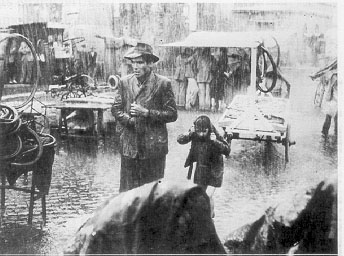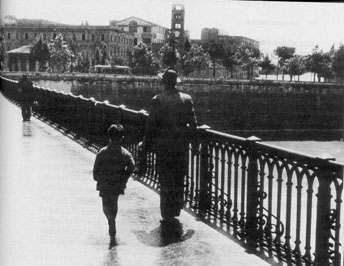
"I think Italian cinema is one of the most creative contributions
modern Italy has made to 20th century culture…" Bondanella
Background
Under Fascism
Antecedents
Neorealism
Demise
Legacy
Bibiography
Bicycle Thieves -Tutorial
"In Moscow, there is such a close and spontaneous relationship
between the nation and the film that these two merge into one". (Pavolini,
1930)
"Not only did the unity between nation and film, which the fascists were eager to attain, speak in favour of the Russian production, but also its aesthetic basis (Pudovkin was about to be translated and everybody had heard about Eisenstein's montage). Russian film was both politics and art, which was a combination representing the highest aspiration of the more knowledgeable fascist film critics" (A. Aprà)
B.Mussolini
- Scipio
- Giovinezza
- Inno
Neorealism: a bolt out of the blue?
"We are in rags? Let's show everyone our rags. We are defeated? Let's look at our disasters. How much we are obliged to the Mafia? To hypocritical bigotry? To conformity, to irresponsibility, to bad breeding? Let's pay all our debts with ferocious love of honesty and the world will participate, moved by this great contest with truth." Lattuada
A
movement in literature, art and the cinema whose roots can be located in
the middle-class realism and ‘verismo’ of the nineteenth century. It came
about in Italy during the period following the Second World War, with the
aim of portraying objectively, with no individualistic or aestheticizing
intervention, the social reality of those years, a reality permeated by
the consequences of war. Although it had begun during the 1930s as a literary
theory and had been characterized in the narrative works which emanated
from the experiences of war and of the Liberation struggle, its most important
manifestations came in the field of the cinema with the works of a handful
of directors, works which, if at times naïve, romantic and populist,
were full of vigorous protest and of a desire for renewal. In borrowing
from the field of literature its scrupulous adherence to reality and to
bare events, the direct transcription of the spoken word, the photographic
representation of fact, this cinema tried to portray an exact image of
life laid bare, created from real life, using ordinary people to play the
parts.
"[Neorealism
was] an ethics of an aesthetics."
"The crisis of neorealism was rooted in an objective general fact:
in the involution of the Italian society or, if we wish to use another
expression, in the restoration of capitalism in Italy. It affected the
arts in different ways. Film received a direct, massive, and brutal blow.
The state used its entire political power and took advantage of the dependence
of film on the industrial structure. All kinds of administrative measures
were used to disrupt a further evolution of neorealism. The blow aimed
at the cinema had a far-reaching effect." C.Salinari
Names that matter:
Directors and films:
L. Visconti - Ossessione
R. Rossellini - Roma città aperta; Paisà; Germania,
anno zero
De Sica - Scuscià; Ladri di biciclette; Miracolo a Milano;
Umberto D
De Santis - Riso amaro; Non c' è pace tra gli ulivi
(A. Lattuada - Il bandito; Senza pietà; Il mulino
del Po')
F. Fellini and A. Antonioni
Scriptwriters & Critics:
U. Barbaro
C. Zavattini
G. De Santis
F. Fellini and A. Antonioni
Influences:
Soviet expressive realism - Eisenstein, Pudovkin
French poetic realism - Jean Renoir
Bibliography:
Millicent Marcus, Italian Film in the Light of Neorealism, Princeton
University Press (UWA - PN1993.5.I8.M3)
Mira Liehm, Passion and Defiance: Film in Italy from 1942 to the
Present,University of California Press (UWA - PN1993.5.I8.L7)
A. Bazin, What is cinema?, University of California Press (UWA
- PN1994.B3)

"My film is dedicated to the suffering of
the humble" Vittorio De Sica
• show things as they are, not as they seem, nor as the bourgeois world would prefer they appear
• reveal the everyday rather than the exceptional; topical scripts inspired by concrete events. Historical and social issues seen from and experienced by the common people.
• portray the individual but as part of society (show a person's relationship to the real social environment rather than to his or her romantic dreams or fantasy role models)
• a documentary visual style; minimal editing/cutting; unobtrusive camera work (arguable)
• shoot on location: usually exteriors; avoid studio and the artificious.
• use non professional actors as far as possible even in main roles
• use of everyday language (non literary) and dialect

Father / son relationship
Antonio the man - partners in misadventure and a bleak future to be
shared;
Bruno a child without childhood - Bruno has his job as petrol attendant
Role of the bicycle
What does it represent in 'this' society ?
What does it represent for Antonio, Bruno and for the wife?
Antonio and social institutions (Police/Church/Trade Unions)
Human Justice / Injustice and Subversion
Realism
How is this achieved ? Only through 'physical' realism?